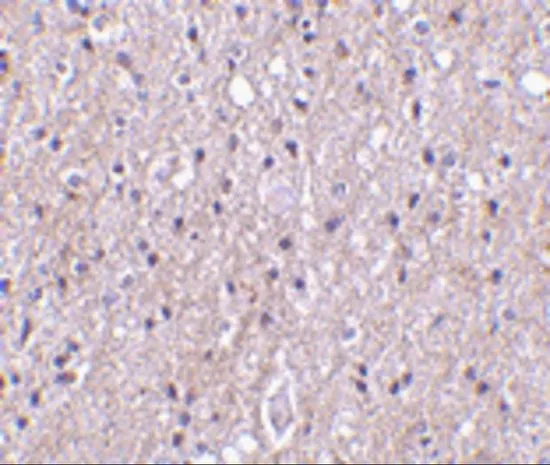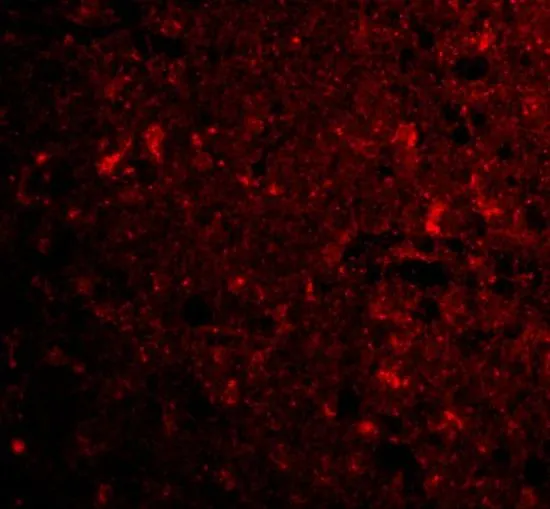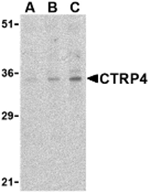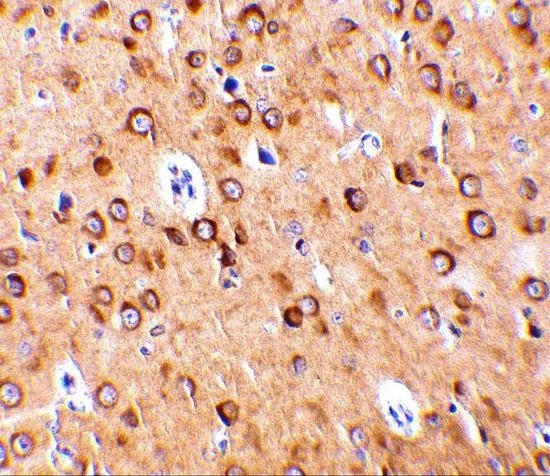
IHC-P analysis of human brain tissue using GTX85503 CTRP4 antibody. Working concentration : 10 microg/ml
CTRP4 antibody
GTX85503
ApplicationsWestern Blot, ELISA, ImmunoHistoChemistry, ImmunoHistoChemistry Paraffin
Product group Antibodies
ReactivityHuman, Mouse, Rat
TargetC1QTNF4
Overview
- SupplierGeneTex
- Product NameCTRP4 antibody
- Delivery Days Customer9
- Application Supplier NoteWB: 1 - 4 microg/mL. IHC-P: 10 microg/mL. *Optimal dilutions/concentrations should be determined by the researcher.Not tested in other applications.
- ApplicationsWestern Blot, ELISA, ImmunoHistoChemistry, ImmunoHistoChemistry Paraffin
- CertificationResearch Use Only
- ClonalityPolyclonal
- Concentration1 mg/ml
- ConjugateUnconjugated
- Gene ID114900
- Target nameC1QTNF4
- Target descriptionC1q and TNF related 4
- Target synonymsCTRP4, ZACRP4, complement C1q tumor necrosis factor-related protein 4, C1q and tumor necrosis factor related protein 4, C1q/TNF-related protein 4, complement-c1q tumor necrosis factor-related protein 4
- HostRabbit
- IsotypeIgG
- Protein IDQ9BXJ3
- Protein NameComplement C1q tumor necrosis factor-related protein 4
- Scientific DescriptionAdipose tissue of an organism plays a major role in regulating physiologic and pathologic processes such as metabolism and immunity by producing and secreting a variety of bioactive molecules termed adipokines (reviewed in 1). One highly conserved family of adipokines is adiponectin/ACRP30 and its structural and functional paralogs, the C1q/tumor necrosis factor-?-related proteins (CTRPs) 1-7 (2). Unlike adiponectin, which is expressed exclusively by differentiated adipocytes, the CTRPs are expressed in a wide variety of tissues (3). These proteins are thought to act mainly on liver and muscle tissue to control glucose and lipid metabolism. An analysis of the crystal structure of adiponectin revealed a structural and evolutionary link between TNF and C1q-containing proteins, suggesting that these proteins arose from a common ancestral innate immunity gene (4). Multiple isoforms of mouse CTRP4 have been reported.
- ReactivityHuman, Mouse, Rat
- Storage Instruction-20°C or -80°C,2°C to 8°C
- UNSPSC12352203






